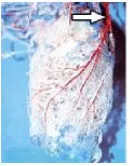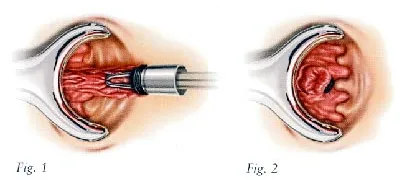Painless Techniques for the Treatment of Hemorrhoids
HAL (Haemorrhoidal Artery Ligation Operation )is designed to eradicate piles without the need for cutting or a general anaesthetic.
The operation uses a miniature Doppler ultrasound device to locate all the arteries supplying the haemorrhoids as they come down from the rectum under the lining of the bowel. The device also has a small window which allows a stitch to be placed around the artery thus cutting off the blood supply to the pile. During the course of the procedure all the arteries supplying the piles are located (up to 6) and tied off. Over the next few days and weeks the pile shrinks away and the symptoms resolve.
Most patients are back to work after 24-48 hours with only a minimum of discomfort, which if there is any, is no more than a mild a throbbing in the rectum.

This cast of a haemorrhoid clearly shows the feeding artery (white arrow) which is carefully located with the HAL procedure.
Because the stitch is placed in the lower rectum, where there are virtually no pain nerves, rather than in the anus the procedure is virtually painless and can be performed under mild sedation rather than a general anaesthetic. Naturally, patients who are a little squeamish about have a procedure to their bottom can elect to have a general anaesthetic if they wish but it is not necessary. Because all of the blood vessels to the piles are accurately located the operation is more successful than injection; and as the blood vessels are properly ligated rather than just looped with a band they will not dislodge, producing a better response with far less risk of bleeding after the procedure.
This procedure has been performed in Europe and North America now for a few years with excellent results. 85% of patients have a complete resolution of their symptoms and over 90% are thoroughly pleased with the result even if there are some very minor residual symptoms. This is due to the relative ease of recovery from the operation compared to more conventional treatments.
Bipolar Coagulation
Bipolar electrotherapy is applied for a directed coagulation effect of the mucous membrane near the hemorrhoid. Specialized Bipolar Circumactive Probes (BICAP) are effective for the treatment of bleeding internal hemorrhoids. Bipolar electrotherapy is applied for a directed coagulation effect of the mucous membrane near the hemorrhoid. Specialized probe designs are effective for the treatment of bleeding internal hemorrhoids. For more detailed information about how electric modalities are used in the treatment of hemorrhoids, view the Electric Treatment Of Hemorrhoids.
Hemorrhoidolysis
Therapeutic galvanic waves applied directly to the hemorrhoid, produces a chemical reaction that shrinks and dissolves hemorrhoidal tissue. This technique is most effective when it is used on internal hemorrhoids. Therapeutic galvanic waves applied directly to the hemorrhoid, produces a chemical reaction that shrinks and dissolves hemorrhoidal tissue. This technique is most effective when it is used on internal hemorrhoids. For more detailed information about how electric modalities are used in the treatment of hemorrhoids, view the Electric Treatment Of Hemorrhoids.
Injection
To shrink the hemorrhoid and its blood vessels, medicine is injected into the mucous membrane near the hemorrhoid. This method is reserved for the smallest of hemorrhoids.
Photocoagulation
A device called a photocoagulator focuses infrared light into a fine point at the end of a probe, which spotwelds the hemorrhoid in place. This is used for hemorrhoids that are actively bleeding.
Rubber Banding
A special instrument fits a small rubber band over part of the hemorrhoid. A tight rubber band stops the blood flow into the pinched-off portion, which falls off in about a week. This technique is widely used for hemorrhoids protruding into the anal canal.
For patients with a lesser degree of prolapse, Rubber Band Ligation is currently the most widely used procedure in the United States for treatment of internal hemorrhoids. In this procedure, the hemorrhoidal tissue is pulled into a double sleeved cylinder to allow the placement of latex/rubber bands around the tissue. (fig. 1) Overtime, the tissue below the bands dies off and is eliminated during a bowel movement. (fig. 2)

Rubber band ligation can be performed in a doctor's office and requires little preparation. Often, however, there is the need for more than one procedure to resolve a patient's condition. Rubber band ligation is most effective when combined with a sclerotherapy injection for prolapse.
Super Freezing
A cryogenic device uses liquid nitrogen to super freeze the hemorrhoid. This causes the affected tissue to slough off, so that new healthy tissue can grow in its place. This technique is most effective when it is used on external hemorrhoids.
HAL (Haemorrhoidal Artery Ligation Operation )is designed to eradicate piles without the need for cutting or a general anaesthetic.









